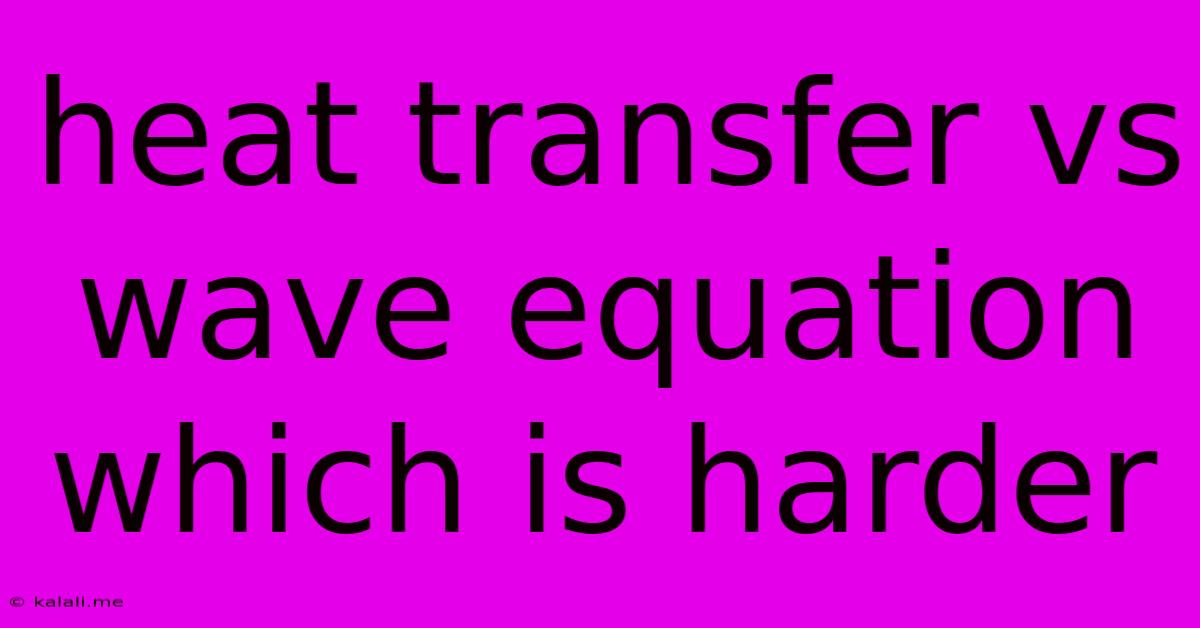Heat Transfer Vs Wave Equation Which Is Harder
Kalali
Jun 01, 2025 · 3 min read

Table of Contents
Heat Transfer vs. Wave Equation: Which is Harder?
The question of whether the heat equation or the wave equation is "harder" is subjective and depends heavily on the context, your mathematical background, and the specific problems you're tackling. Both are fundamental partial differential equations (PDEs) with numerous applications in physics and engineering, but they possess distinct characteristics that make them challenging in different ways. This article explores the complexities of each equation, offering a comparative analysis to help you understand their relative difficulty.
What are the Heat and Wave Equations?
Both equations describe the evolution of a physical quantity over time and space. The heat equation models the diffusion of heat, while the wave equation describes the propagation of waves.
-
Heat Equation: This equation models how temperature changes over time due to heat conduction. It's typically written as: ∂u/∂t = α∇²u, where 'u' represents temperature, 't' is time, 'α' is thermal diffusivity, and ∇² is the Laplacian operator. The heat equation is a parabolic PDE.
-
Wave Equation: This equation describes how waves propagate through a medium. Its standard form is: ∂²u/∂t² = c²∇²u, where 'u' represents the wave displacement, 't' is time, 'c' is the wave speed, and ∇² is the Laplacian operator. The wave equation is a hyperbolic PDE.
Comparing the Challenges:
While both equations involve solving PDEs, their characteristics present different levels of complexity:
Challenges of the Heat Equation:
- Initial Conditions: The heat equation is often solved with an initial condition specifying the temperature distribution at time t=0. This initial condition can be complex, making the solution challenging.
- Boundary Conditions: The boundary conditions, which describe how the temperature behaves at the edges of the domain, can significantly influence the solution. Different types of boundary conditions (Dirichlet, Neumann, Robin) require different solution techniques.
- Numerical Methods: Solving the heat equation numerically can be computationally expensive, particularly for complex geometries or high-resolution simulations. Numerical instability is also a potential issue.
- Understanding Diffusion: Grasping the concept of diffusion and how it's manifested in the equation's solutions is crucial for a deep understanding.
Challenges of the Wave Equation:
- Second-Order Time Derivative: The presence of a second-order time derivative in the wave equation adds complexity compared to the first-order time derivative in the heat equation. This requires solving for both displacement and velocity.
- Characteristic Curves: Understanding characteristic curves is vital for solving the wave equation, especially in cases with non-constant wave speeds.
- Wave Phenomena: Understanding wave phenomena like reflection, refraction, diffraction, and superposition is essential for correctly interpreting solutions.
- Dispersion and Dissipation: Depending on the medium, waves might exhibit dispersion (different frequencies travel at different speeds) or dissipation (loss of energy over time). Accounting for these effects can increase the difficulty.
So, Which is Harder?
There's no definitive answer. The relative difficulty depends on the specific problem. Simple, one-dimensional cases of both equations might be relatively straightforward, while more complex, multi-dimensional problems with non-linear terms or irregular boundaries can become extremely challenging for both.
The heat equation often involves dealing with more complicated boundary conditions and may require more sophisticated numerical techniques for efficient computation. The wave equation presents its own set of challenges with its second-order time derivative and the inherent complexities of wave phenomena.
Ultimately, mastering both equations requires a strong foundation in calculus, differential equations, and potentially numerical methods. The "harder" equation will depend on your strengths and weaknesses and the specific problem at hand. Both offer valuable insights into fundamental physical processes and represent significant achievements in mathematical physics.
Latest Posts
Latest Posts
-
How Long Is Worcestershire Sauce Good For
Jun 02, 2025
-
Is A 1031 Exchange Bad For A Seller
Jun 02, 2025
-
How To Write Seconds And Minutes
Jun 02, 2025
-
How Is Jon Spelled The Most
Jun 02, 2025
-
Refrigerator Water Line Copper To Plastic
Jun 02, 2025
Related Post
Thank you for visiting our website which covers about Heat Transfer Vs Wave Equation Which Is Harder . We hope the information provided has been useful to you. Feel free to contact us if you have any questions or need further assistance. See you next time and don't miss to bookmark.